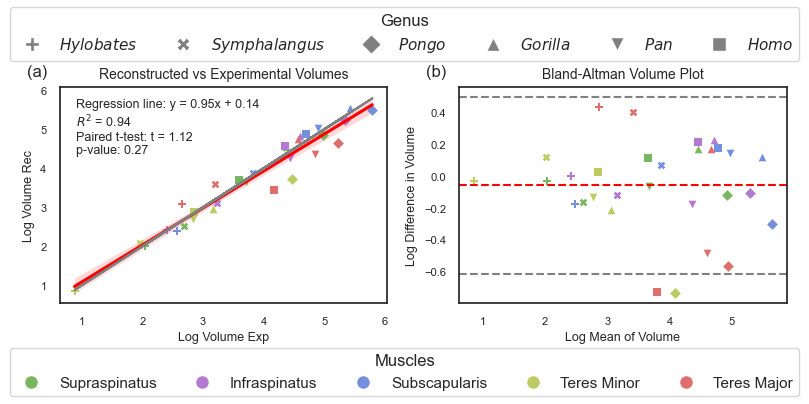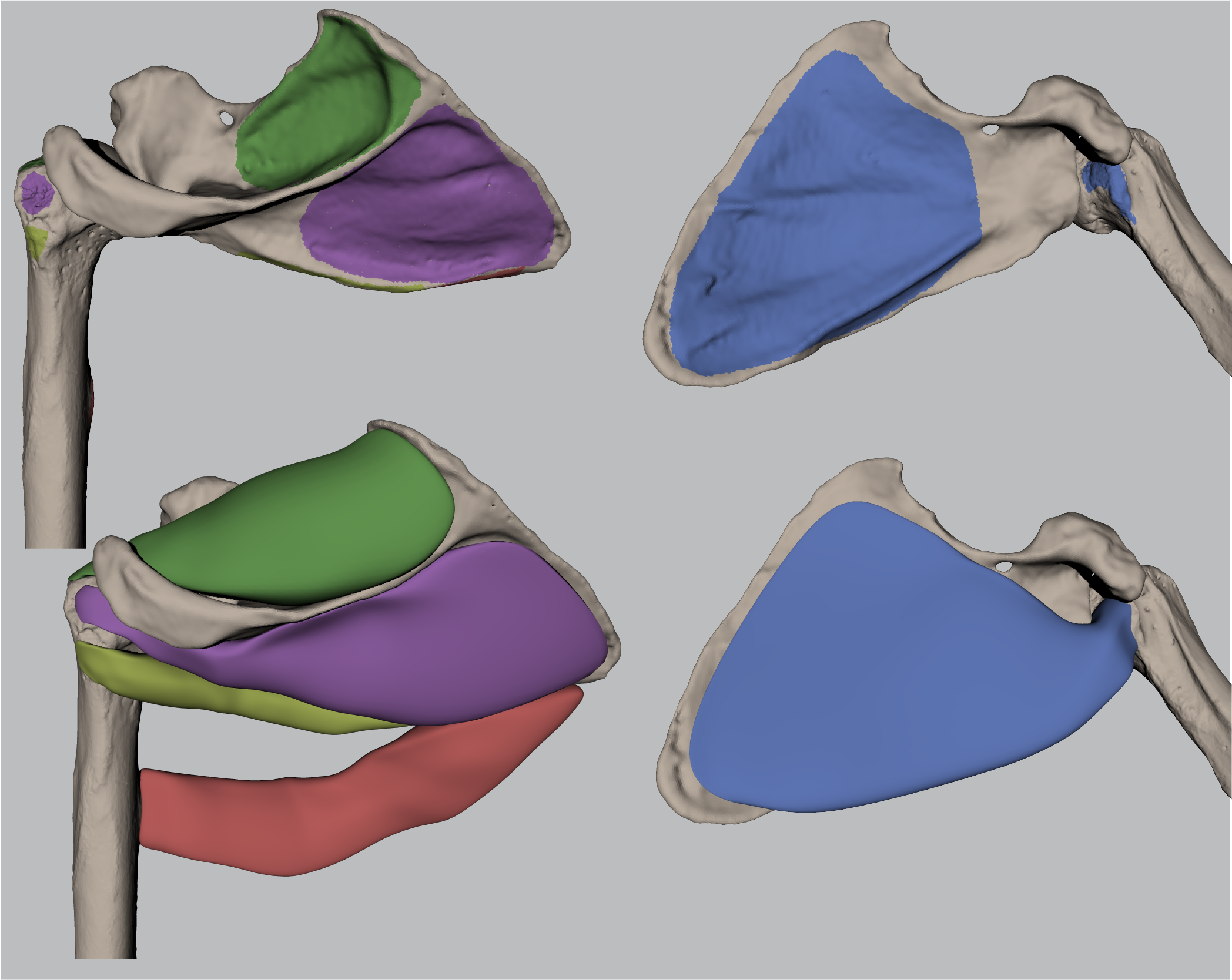1. Results 3.2 Paired T-Test and Regression Analysis for Muscle Volumes#
In this chapter, a paired t-test and regression analysis is performed to compare the reconstructed 3D muscle volumes with experimental measurements. The results of the analysis and the figures are presented in the manuscript in section 3.2 “Accuracy of Muscle Volume and Length Reconstruction”.
1.1. Imports#
Required packages for this analysis can be found in the requirements.txt file. Ensure that all
dependencies are installed before running the script.
Show code cell source
import matplotlib.pyplot as plt
import numpy as np
import pandas as pd
from scipy.stats import ttest_rel
from scipy import stats
import os
from sklearn.metrics import mean_absolute_error, mean_squared_error, r2_score
import statsmodels.api as sm
import seaborn as sns
# Setting global styles for plots
sns.set(style='white')
# ANSI escape code for bold text in print
bold_start = "\033[1m"
bold_end = "\033[0m"
1.2. Input Setup#
Loads the Muscle_data.xlsx file containing all original data and removes specimens where 3D reconstructions have not been performed.
Show code cell source
# Load the data from the provided Excel file
file_path = os.path.join('Muscle_data.xlsx')
data = pd.read_excel(file_path)
# Filter out specimens with missing data
data = data[~data['Specimen_ID'].isin([130, 131, 129])]
# log transform data
exp_volumes = np.log(data['Volume_exp (cm³)'])
poly_volumes = np.log(data['Volume_rec (cm³)'])
# store muscle names and species names
muscle_names = data['Muscle_Name']
specimen_names = data['Genus']
1.3. Paired T-Test#
Performs a paired t-test of the experimental volumes against the reconstructed volumes and prints the t-statistic and p-value.
Show code cell source
# Perform paired t-test to compare reconstructed and experimental measurements
t_stat, p_value = ttest_rel(exp_volumes, poly_volumes)
print(f"Paired t-test t-statistic: {t_stat:.2f}")
print(f"Paired t-test p-value: {bold_start}{p_value:.2f}{bold_end}")
Paired t-test t-statistic: 1.12
Paired t-test p-value: 0.27
1.4. Linear Regression and Visualization#
Show code cell source
# Perform linear regression
X = sm.add_constant(exp_volumes)
model = sm.OLS(poly_volumes, X).fit()
intercept, slope = model.params
r_squared = model.rsquared
# Print the regression summary in a clear format
print(model.summary())
# Define the desired order of muscle names
desired_order_muscle = ['Supraspinatus', 'Infraspinatus', 'Subscapularis', 'Teres Minor', 'Teres Major']
# Define the desired order of specimen
desired_order_specimen = ['Hylobates', 'Symphalangus', 'Pongo', 'Gorilla', 'Pan', 'Homo']
# Define the custom colors for each muscle
custom_colors = {
'Supraspinatus': (0.467, 0.710, 0.367),
'Infraspinatus': (0.7, 0.47, 0.82),
'Subscapularis': (0.45, 0.56, 0.87),
'Teres Minor': (0.741, 0.8, 0.384),
'Teres Major': (0.871, 0.435, 0.427)
}
# Define unique markers for specimen
custom_markers = {
'Hylobates': 'P',
'Symphalangus': 'X',
'Pongo': 'D',
'Gorilla': '^',
'Pan': 'v',
'Homo': 's'
}
# Create a mapping of muscle names to colors based on the desired order
muscle_to_color = {muscle: custom_colors[muscle] for muscle in desired_order_muscle}
# Create figure for regression and Bland-Altman plots
fig, axes = plt.subplots(1, 2, figsize=(8, 4))
# Plot Linear Regression (left subplot)
ax1 = axes[0]
# Scatter and regression plot
sns.regplot(x=exp_volumes, y=poly_volumes, ax=ax1, data=data, scatter=False, color='red', label='Regression line')
# Scatter plot of the log-transformed data points
for muscle in desired_order_muscle:
for specimen in desired_order_specimen:
mask = (data['Muscle_Name'] == muscle) & (data['Genus'] == specimen)
ax1.scatter(exp_volumes[mask], poly_volumes[mask],
color=muscle_to_color[muscle],
marker=custom_markers[specimen],
linewidths=0.01,
s=30)
# plot identity line
ax1.plot(exp_volumes, exp_volumes, color='grey')
ax1.set_title('Reconstructed vs Experimental Volumes', fontsize=10)
ax1.set_xlabel('Log Volume Exp', fontsize=9)
ax1.set_ylabel('Log Volume Rec', fontsize=9)
equation_text = f'Regression line: y = {slope:.2f}x + {intercept:.2f}\n$R^2$ = {r_squared:.2f}\nPaired t-test: t = {t_stat:.2f}\np-value: {p_value:.2f}'
ax1.annotate(equation_text,
xy=(0.05, 0.95), xycoords='axes fraction', fontsize=9,
horizontalalignment='left', verticalalignment='top'
)
# Apply custom font to tick labels
ax1.tick_params(axis='both', which='major', labelsize=8)
for label in (ax1.get_xticklabels() + ax1.get_yticklabels()):
label.set_size(8)
# Add annotation "a"
ax1.annotate('(a)', xy=(-0.1, 1.05), xycoords='axes fraction', fontsize=12)
# Plot Bland-Altman Plot (right subplot)
differences = poly_volumes - exp_volumes
means = np.mean([poly_volumes, exp_volumes], axis=0)
ax2 = axes[1]
ax2.axhline(y=np.mean(differences), color='red', linestyle='--')
ax2.axhline(y=np.mean(differences) + 1.96*np.std(differences), color='gray', linestyle='--')
ax2.axhline(y=np.mean(differences) - 1.96*np.std(differences), color='gray', linestyle='--')
for muscle in desired_order_muscle:
for specimen in desired_order_specimen:
mask = (muscle_names == muscle) & (specimen_names == specimen)
ax2.scatter(means[mask], differences[mask],
color=muscle_to_color[muscle],
marker=custom_markers[specimen],
linewidths=0.01,
s=30)
ax2.set_title('Bland-Altman Volume Plot', fontsize=10)
ax2.set_xlabel('Log Mean of Volume', fontsize=9)
ax2.set_ylabel('Log Difference in Volume', fontsize=9)
# Apply custom font to tick labels
ax2.tick_params(axis='both', which='major', labelsize=8)
for label in (ax2.get_xticklabels() + ax2.get_yticklabels()):
label.set_size(8)
# Add annotation "a"
ax2.annotate('(b)', xy=(-0.1, 1.05), xycoords='axes fraction', fontsize=12)
# Create legends
handles_muscles = [plt.Line2D([0], [0], marker='o', color='w', label=muscle,
markerfacecolor=color, markersize=10)
for muscle, color in muscle_to_color.items()]
# Create handles with italicized labels
handles_specimen = [
plt.Line2D(
[0], [0],
marker=marker,
color='w',
label=f'${specimen}$', # Italicize the label here
markerfacecolor='gray',
markersize=10
)
for specimen, marker in custom_markers.items()
]
# Add legends above and below the plots
fig.legend(handles=handles_specimen, title='Genus', loc='upper center', ncol=6)
fig.legend(handles=handles_muscles, title='Muscles', loc='lower center', ncol=6)
# Display plots with adjusted layout
plt.tight_layout(rect=[0, 0.1, 1, 0.9]) # Leave space for legends
plt.show()
OLS Regression Results
==============================================================================
Dep. Variable: Volume_rec (cm³) R-squared: 0.943
Model: OLS Adj. R-squared: 0.941
Method: Least Squares F-statistic: 459.4
Date: Mon, 28 Oct 2024 Prob (F-statistic): 6.54e-19
Time: 08:16:40 Log-Likelihood: -4.1266
No. Observations: 30 AIC: 12.25
Df Residuals: 28 BIC: 15.06
Df Model: 1
Covariance Type: nonrobust
====================================================================================
coef std err t P>|t| [0.025 0.975]
------------------------------------------------------------------------------------
const 0.1380 0.176 0.785 0.439 -0.222 0.498
Volume_exp (cm³) 0.9481 0.044 21.435 0.000 0.857 1.039
==============================================================================
Omnibus: 2.337 Durbin-Watson: 1.741
Prob(Omnibus): 0.311 Jarque-Bera (JB): 1.685
Skew: -0.580 Prob(JB): 0.431
Kurtosis: 2.960 Cond. No. 14.1
==============================================================================
Notes:
[1] Standard Errors assume that the covariance matrix of the errors is correctly specified.

Fig. 1.1 Manuscript Figure 3: Accuracy of muscle volume reconstructions. (a) Linear regression of reconstructed (rec) muscle volumes compared to experimentally (exp) measured ones. The red line illustrates the optimal linear regression fit, surrounded by a red shaded area representing the 95% confidence interval of that regression. The grey line represents the identity line. (b) Bland-Altman plot displaying the differences between log-transformed experimental and reconstructed muscle volumes. The mean difference between the two measurements is shown by a red dashed line, while the grey dashed lines indicate the limits of agreement, which are determined as the mean difference ± 1.96 times the standard deviation of the differences.#
1.5. Error Metrics#
Determines the Mean Absolute Error, Root Mean Squared Error and Coefficient of Determination.
Show code cell source
# Calculate MAE and RMSE
mae = mean_absolute_error(exp_volumes, poly_volumes)
rmse = np.sqrt(mean_squared_error(exp_volumes, poly_volumes))
r2 = r2_score(exp_volumes, poly_volumes)
# Display error metrics in a table format
print(f"Mean Absolute Error (MAE): {mae:.2f}")
print(f"Root Mean Squared Error (RMSE): {rmse:.2f}")
print(f"Coefficient of Determination (R²): {r2:.2f}")
Mean Absolute Error (MAE): 0.22
Root Mean Squared Error (RMSE): 0.29
Coefficient of Determination (R²): 0.94
1.6. Tests Difference from Identity Line#
In linear regression, we often want to know if the slope is different from 1, which would indicate a deviation from a perfect one-to-one relationship between the variables. High p-values (above 0.05) would indicate that the slope does not significantly differ from 1 and the intercept does not significantly differ from 0.
Show code cell source
intercept_se, slope_se = model.bse # Standard errors for the intercept and slope
t_stat_slope, t_stat_intercept = model.tvalues # t-statistics for testing if the slope = 0 and intercept = 0
# Calculating the t-statistic for testing if the intercept is significantly different from 0
# A t-statistic compares the estimated intercept against 0 to check if it is significantly different.
intercept_t_stat = (intercept - 0) / intercept_se
# To test if the slope is significantly different from 1, we adjust the hypothesis:
# Here, we subtract 1 from the estimated slope, then check if the result is significantly different from 0.
t_stat_slope_vs_1 = (slope - 1) / slope_se
# Calculate the p-value for the t-statistic of the slope vs 1
# The p-value indicates the probability of observing this result under the null hypothesis (slope = 1).
p_value_slope_vs_1 = 2 * (1 - stats.t.cdf(abs(t_stat_slope_vs_1), df=len(exp_volumes) - 2))
# Calculate the p-value for testing if the intercept is different from 0
# This p-value helps determine if the intercept differs significantly from 0.
intercept_p_value = 2 * (1 - stats.t.cdf(abs(intercept_t_stat), df=len(exp_volumes) - 2))
# Print the results of the hypothesis tests
print(f"t-statistic for intercept vs 0: {t_stat_intercept:.2f}")
print(f"p-value for intercept vs 0: {bold_start}{intercept_p_value:.2f}{bold_end}")
print(f"t-statistic for slope vs 1: {t_stat_slope_vs_1:.2f}")
print(f"p-value for slope vs 1: {bold_start}{p_value_slope_vs_1:.2f}{bold_end}")
t-statistic for intercept vs 0: 21.43
p-value for intercept vs 0: 0.44
t-statistic for slope vs 1: -1.17
p-value for slope vs 1: 0.25
